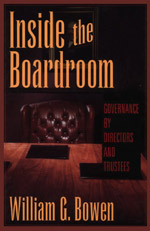(Reprinted with permission from the Journal of Higher Education, written by Peter Frumkin.)
The independent or nonprofit sector is a conglomeration of more than one million different organizations and today represents one of the fastest growing parts of American society. Universities and colleges, because of the endowments they control and the tuition revenues they collect annually, make up some of the largest and most stable organizations in this sector, which includes everything from homeless shelters to arts organizations to health clinics. William Bowen, former president of Princeton University and now the president of the Andrew W. Mellon Foundation, has written two new comparative books, one that examines patterns of institutional growth and decline within the nonprofit sector and another that probes the responsibilities of trustees in managing large organizations. By situating colleges and universities within the broader nonprofit landscape, Bowen manages to enlarge the frame of reference for discussions of higher education.
The goal of The Charitable Nonprofits is to provide a road map through the nonprofit sector and to explore the developmental pathways of nonprofit organizations. Excluded from study is the myriad of civic, labor, and cooperative organizations that also enjoy tax-exemption but are not eligible to receive tax-deductible charitable contributions. Within the charitable subfield, Bowen and his three associates from the Mellon Foundation narrow their focus one step further and consider only larger organizations, charitable nonprofits with revenues over $25,000—some 122,221 organizations or about 12 percent of the entire nonprofit landscape. Described are the central features of these large charitable nonprofits, the rates of institutional formation and growth within selected fields over time, and the factors that shape the success and failure of charitable organizations.
Bowen’s comparative framework allows one to see how the forces that drive institutional formation within higher education have been dramatically different than those that shape the birth rates of other kinds of nonprofit organizations, some of which have been influenced by changes in the tax code and intergenerational transfers of wealth.
The core chapters of The Charitable Nonprofits explore the relationships among a nonprofit organization’s size, its field of activity, its sources of revenue, and its age. Within a comparative framework that includes museums, performing arts organizations, historical societies, and institutions of higher education, Bowen considers the relationship between various combinations of his four institutional factors. By pursuing his investigation within a framework that cuts across a range of nonprofit organizations, Bowen is able to highlight both the special challenges universities and colleges confront and the advantages they enjoy. This comparative exercise, as well as many others throughout the book, is a useful antidote to narrower studies that start and end with specialized data relating only to colleges and universities.
Bowen returns to the field of higher education in a later chapter and considers closing or failure rates between 1981 and 1991. While 408 institutions of higher education failed during this decade, but that the annual exit rate of 2 percent among institutions of higher education is approximately the same as that of ballet companies, operas, and theaters. This is an unexpected finding, given the fact that private colleges and universities appear to be large, stable institutions possessing significant assets, especially when compared to many financially frail arts organizations. However, Bowen reveals that 90 percent of the failed colleges and universities were unaccredited, more dependent on tuition revenue, and therefore more subject to failure due to declines in student enrollment.
 Bowen’s other recent book, Inside the Boardroom, examines the role of trustees and directors in the governance of both business firms and nonprofit organizations.
Bowen’s other recent book, Inside the Boardroom, examines the role of trustees and directors in the governance of both business firms and nonprofit organizations.
Bowen has extensive personal experience serving on boards. He has been a director of major corporations, including American Express, NCR, and Merck, and has also served as a director or trustee of many nonprofit organizations, including, among others, the Smithsonian Institution, the Sloan Foundation, Princeton University, and the Center for Advanced Study in the Behavioral Sciences.
Drawing on this wealth of experience, Bowen devotes considerable attention to defining clearly the essential functions of a board, such as hiring and firing the chief executive, long-term strategic planning, ensuring that needed resources are in place to achieve objectives, monitoring the performance of management, and nominating suitable candidates for election to the board. Bowen is able to discern twenty essential principles—what he terms “presumptive norms”—for effective board governance; these cut across all organizations. They include a focus on courage and empathy as key attributes when selecting outside directors, the value of board diversity as long as it does not sacrifice agreement on the institution’s mission, and the need for term limits on board service and mechanisms for monitoring the performance of directors. Most of the other norms are common sense, but Bowen manages to illustrate their importance within different organizational contexts—not just within the context of managing a university.
The informal tone and clear organization of this book make it easy to read and navigate. What differentiates Inside the Boardroom from existing books is the wealth of experience that underlies the work and its cross-sector approach. Further, Bowen condenses his ideas to their most important and universal components.
The differences between business firms and nonprofit organizations can be boiled down to the fact that for-profit boards must focus on enhancing shareholder value whereas nonprofit boards must remain committed to an organization’s mission no matter what the cost. Beyond this essential difference, effective boards—regardless of their sector—are best off when they follow the same set of rules and precepts.
Useful Rubrics
-
Focus on courage and empathy when choosing a director.
-
Value diversity as long as it does not sacrifice agreement on the institution’s central mission.
-
Set term limits.
-
Have mechanisms for monitoring directors’ performance.
-
Use common sense.
—adapted from Inside the Boardroom